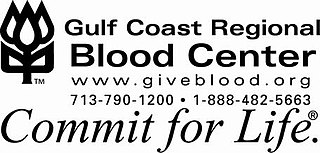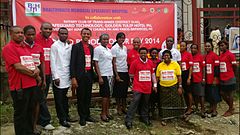
A blood type is a classification of blood, based on the presence and absence of antibodies and inherited antigenic substances on the surface of red blood cells (RBCs). These antigens may be proteins, carbohydrates, glycoproteins, or glycolipids, depending on the blood group system. Some of these antigens are also present on the surface of other types of cells of various tissues. Several of these red blood cell surface antigens can stem from one allele and collectively form a blood group system.

Blood transfusion is the process of transferring blood products into a person's circulation intravenously. Transfusions are used for various medical conditions to replace lost components of the blood. Early transfusions used whole blood, but modern medical practice commonly uses only components of the blood, such as red blood cells, white blood cells, plasma, platelets, and other clotting factors.
Transfusion medicine is the branch of medicine that encompasses all aspects of the transfusion of blood and blood components including aspects related to hemovigilance. It includes issues of blood donation, immunohematology and other laboratory testing for transfusion-transmitted diseases, management and monitoring of clinical transfusion practices, patient blood management, therapeutic apheresis, stem cell collections, cellular therapy, and coagulation. Laboratory management and understanding of state and federal regulations related to blood products are also a large part of the field.

A blood donation occurs when a person voluntarily has blood drawn and used for transfusions and/or made into biopharmaceutical medications by a process called fractionation. Donation may be of whole blood, or of specific components directly (apheresis). Blood banks often participate in the collection process as well as the procedures that follow it.
NHS Blood and Transplant is an executive non-departmental public body of the United Kingdom's Department of Health and Social Care. It was established on 1 October 2005 to take over the responsibilities of two separate NHS agencies: UK Transplant, founded by Dr. Geoffrey Tovey in 1972, and the National Blood Service. Its remit is to provide a reliable, efficient supply of blood, organs and associated services to the NHS. Since NHSBT was established, the organisation has maintained or improved the quality of the services delivered to patients, stabilised the rising cost of blood, and centralised a number of corporate services.
The International Society of Blood Transfusion (ISBT) is a scientific society founded in 1935 G.C, which promotes the study of blood transfusion and provides information about the ways in which blood transfusion medicine and science can best serve patients' interests. The society's central office is in Amsterdam, and there are around 1500 members in 103 countries. Currently, the President is Michael Busch.
The New Zealand Blood Service is the provider of blood services for New Zealand. The service is a Crown entity responsible to New Zealand's Parliament and is governed by a Board appointed by the Minister of Health.
Founded in 1962, America's Blood Centers (ABC) is an association of independent non-profit blood centers that operates in Canada and the United States. ABC member organizations operate more than 600 blood collection sites providing close to 60 percent of the U.S., and a quarter of the Canadian, blood supply. These blood centers serve more than 150 million people and provide blood products and services to more than 3,500 hospitals and healthcare facilities across North America. All ABC U.S. members are licensed and regulated by the U.S. Food and Drug Administration. Kate Fry, MBA, CAE, currently leads the organization as Chief Executive Officer.

Karl Landsteiner was an Austrian-born American biologist, physician, and immunologist. He emigrated with his family to New York in 1923 for professional opportunities, working for the Rockefeller Institute.

The Associazione Volontari Italiani del Sangue (AVIS) is the major Italian non-profit and charitable organisation for blood donation, bringing together over a million volunteer blood donors across Italy. It is headquartered in Lombardy, Italy.
Prathama Blood Centre is blood bank situated at Ahmedabad, jointly established in 2000, by Ahmedabad Municipal Corporation and Advanced Transfusion Medicine Research Foundation as non-profit voluntary organization. About 50,000 voluntary blood donors donate blood annually at Prathama which is India's first fully automated blood center.

Gulf Coast Regional Blood Center is the only blood provider in Houston and its surrounding communities 24 hours a day, 7 days a week. It is one of the largest independent community blood centers in the United States serving 26 counties from the Texas Gulf Coast to Brazos Valley to East Texas. The nonprofit supplies blood to more than 170 hospitals and health care institutions including the Texas Medical Center, the largest medical center in the world. Gulf Coast Regional Blood Center is a proud member of the American Association of Blood Banks (AABB), Blood Centers of America, South Central Association of Blood Banks, Texas Medical Center and America's Blood Centers. Operations started on January 1, 1975, with 64 employees. Today, Gulf Coast Regional Blood Center has over 650 staff members. The overall supervision of Gulf Coast Regional Blood Center's activities is the responsibility of a chief executive officer appointed by the board of trustees. Medical supervision and direction for Gulf Coast Regional Blood Center are provided by a Chief Medical Officer also appointed by the board of trustees.
Husaini Blood Bank (HBB) is a public health organization with its headquarter at Karachi and working for the welfare of the people of Pakistan via its sub offices and affiliated department/NGOs all over the country. HBB was founded in 1979 by Dr Hasan Ali Vajid with the establishment of Husaini Haematology and Oncology Trust inside his Clinic at Soldier Bazar Karachi through the support of Mr Hamid D. Habib, the chairman of Habib Trusts and started blood collection and donation at a very small scale.
Blood transfusion was first performed in Sri Lanka in late 1950. It became more widely known to the public in 1959 after the assassination of Prime Minister S.W.R.D. Bandaranaike, when an appeal was made to the public to donate blood. The country's blood bank system has since expanded from a single initial site to multiple blood donation centres and laboratories nationwide, operating under the auspices of the National Blood Transfusion Service (NBTS). As of 2014, the NBTS collects over 350,000 voluntary blood donations every year.

The MSM blood donor controversy in the United Kingdom refers to the former deferral policy of men who have had sex with men (MSM) in the United Kingdom who wish to donate their blood to UK blood donation services. Since June 2021, there is no deferral period in all four home nations. This followed an announcement in December 2020 that blood donation policies specific to MSM would be scrapped in favour of personalised risk assessment based on sexual behaviour.

Dr. Jai Gopal Jolly, famously known as Dr. J. G. Jolly was an Indian physician and professor of the Department of Transfusion Medicine at the Post Graduate Institute of Medical Education and Research, Chandigarh, India. He is an internationally known expert in the field of blood transfusion, who pioneered the voluntary blood donation movement in India, and is regarded as the "Father of Transfusion Medicine in India". He spearheaded the campaign to prohibit sale and purchase of blood from professional donors in India, which was later incorporated into the National Blood Policy of India by the Government of India. He has generated awareness among the masses about the significance of blood donation programmes by observing "Blood Donation Day" on 1 October. This has helped in obtaining adequate quantity of quality blood from voluntary donors. His dedicated work has contributed magnificently to the development and excellence in professional service, research and teaching in the field of Transfusion Medicine in India.
The International Federation of Blood Donor Organizations is the international organization representing the voluntary, anonymous and non-remunerated blood donors.
Blood donation in Bangladesh is an activity conducted by several different organisations. As of 2011, about 25% of the nation's blood supply came from voluntary donation, 20–25% from paid donors, and 50–55% from one-time donation for a specific patient.
Blood donations in India are conducted by organisations and hospitals through blood donation camps. Donors can also visit blood banks in hospitals to donate blood. Efforts by the government and advocacy groups over the years have helped bridge the gap between demand and supply. The regulatory framework for blood donation and blood bank management rests with the Central Drugs Standard Control Organisation, while technical bodies like the National Blood Transfusion Council and National AIDS Control Organisation formulate guidelines and recommendations for transfusion medicine and blood bank management. Challenges persist with regards to regulation of blood banks and transfusion practices as the sector is largely fragmented with uneven distribution of blood banks and supply of blood in parts of the country. Donors are usually provided with refreshments after the procedure, which include glucose drinks, biscuits and fruits. Some organisations offer transportation facilities, as well as certificates or badges as gratitude.









